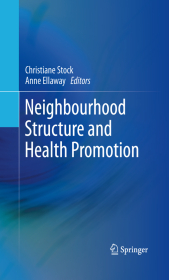 Neuerscheinungen 2015Stand: 2020-02-01 |
Schnellsuche
ISBN/Stichwort/Autor
|
Herderstraße 10
10625 Berlin
Tel.: 030 315 714 16
Fax 030 315 714 14
info@buchspektrum.de |

Anne Ellaway, Christiane Stock
(Beteiligte)
Neighbourhood Structure and Health Promotion
Herausgegeben von Stock, Christiane; Ellaway, Anne
2013. 2015. viii, 367 S. 235 mm
Verlag/Jahr: SPRINGER, BERLIN; SPRINGER US; SPRINGER 2015
ISBN: 1-489-99754-7 (1489997547)
Neue ISBN: 978-1-489-99754-8 (9781489997548)
Preis und Lieferzeit: Bitte klicken
Offering innovative methods for measuring and monitoring links between place and health, this book analyzes neighbourhood conditions and characteristics, people´s perceptions of where they live, and behaviour from diet to smoking, drinking and drug use.
It has long been theorized that people living in poor areas have more health problems than their more advantaged peers. More recently, science has been testing this hypothesis, concentrating on the impact of the built environment on well-being and its contribution to health inequities.
Neighbourhood Structure and Health Promotion offers sociology-based theory and evidence-based findings so readers may better understand the effects of place on health choices, behaviour, and outcomes. This international volume analyzes the complex relationships among neighbourhood conditions and characteristics, people´s perceptions of where they live, and their everyday health lives, from eating habits and activity levels to smoking, drinking, and drug use. Chapters introduce innovative methods for measuring and monitoring links between place and health in terms of risks and resources, and employing objective and subjective data. Prospects for engaging neighbourhoods in prevention efforts, particularly involving young people, and policy implications for the future of health promotion and inequity reduction are discussed as well. Included in the coverage:
The spatiality of injustice: area effects on behaviour.
Qualitative and quantitative methods for assessing neighbourhood health resources.
The potential of GIS and GPS in the health sciences.
Green spaces and health: possibilities for research and policy.
School neighbourhoods and obesity prevention in youth.
Connecting gender, social environment, and health.
Neighbourhood Structure and Health Promotion advances the study of this increasingly critical topic, making it a valuable reference for researchers, practitioners, policy makers and advanced students in health, health promotion, social epidemiology, and urban planning.
1. Neighbourhood structure and health promotion: An introduction.- Part 1: Understanding health as a matter of place .- 2. Neighbourhood context and mortality: An overview.- 3. Area effects on behaviour and lifestyle: The spatiality of injustice.- 4. Sociological perspectives on neighbourhood context and health.- 5. People and place: The interrelated connections between interactions, behaviour, relations, perceptions and space.- Part 2: Measuring and monitoring neighbourhood structure .- 6. Methods to measure neighbourhoods and analyse their impact on health: An overview.- 7. Access to health promoting facilities and amenities.- 8. GIS: A spatial turn in the health science?.- 9. Using GPS to measure the interaction between individuals and their neighbourhood.- 10. Mathematical approaches to analyzing area level effects on health.- Part 3: Neighbourhood and lifestyle .- 11. Vitamin G - Green spaces and health: Potential mechanisms and policy implications, and ideas for further research.- 12. Socio-economic differences in physical activity: The role of neighbourhood factors.- 13. Building in prevention: Nudging towards physical activity and public health.- 14 .Rethinking exposure in area studies on social inequities in smoking in youth and young adults.- 15. Neighbourhood structure and alcohol and other drug use: Implications for prevention.- 16. Neighbourhoods and healthy nutrition.- 17. School neighbourhoods and obesity prevention in youth.- 18. Connecting gender, space and place: Are there gender differences in the relationships between the social environment and health-related behaviours?.- 19. From neighbourhood and health research to health promotion practice.


